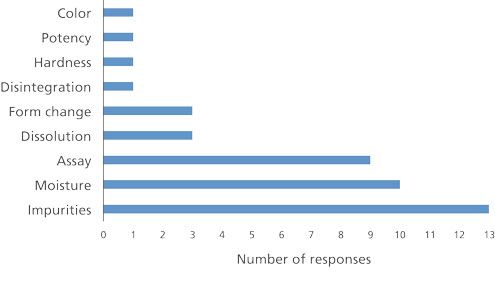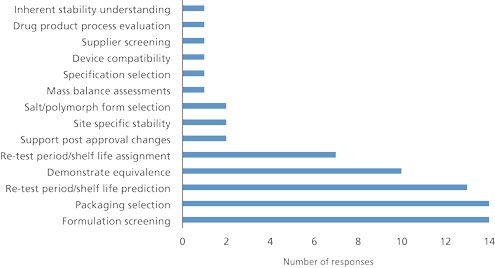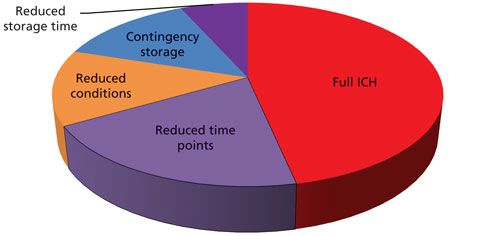Risk-Based Predictive Stability–An Industry Perspective
A survey on risk-based predictive stability tools reveals how pharma companies are leveraging advanced stability approaches throughout the drug development process.
ashkin/shutterstock.com

The science of stability has significantly evolved since the advent of International Council for Harmonization (ICH) Q1A (1). This guideline has been in effect for more than a decade and offers the benefit of global harmonization. However, divergent local regulatory expectations in accordance with this guideline have frequently increased both time and cost required for developing new molecular entities and can ultimately delay bringing new medicines to patients. Nevertheless, improved modeling tools coupled with the appropriate protocols have enabled similar or better stability predictions within accelerated timeframes when compared to a more traditional ICH approach (2–4). These tools provide increased understanding of the attributes that influence drug substance and product stability instead of following the traditional ICH approach that simply demonstrates stability in an empirical manner. These modern tools and approaches are well aligned with the science- and risk-based approaches detailed in ICH Q8–Q11 (5–8) and have been termed risk-based predictive stability (RBPS). Companies are using these RBPS tools to enable development (9). The perception, however, is that the application of these tools has been inconsistent across the industry. Additionally, there is no acknowledgement of these RBPS tools within regulatory guidance documents.
In 2015, the International Consortium for Innovation and Quality in Pharmaceutical Development consortium (IQ) launched a working group to focus on the use of RBPS tools to optimize pharmaceutical development. The working group has approximately 50 members from 18 companies across the pharmaceutical industry. During the initial conversations within the group, it became clear that there is considerable variability in the implementation of these tools and their use (and success) in regulatory applications. This realization led to the conclusion that the industry was not aligned in how to leverage the knowledge these RBPS tools provide, which prompted the working group to conduct a survey to understand sponsor companies’ experiences using RBPS tools. The survey, consisting of 56 questions, was conducted during 2016. The focus was on RBPS tools and excluded concepts associated with lean stability as discussed in the literature (10).
Results
Of the 18 companies that responded to the survey, 16 indicated they use RBPS. Responses from 18 companies represent approximately 58% of the IQ Consortium Analytical Leadership Group (11). Respondents represented a cross section of the pharmaceutical industry including large and small molecules as well as generic drug products. The list of respondents is provided in Table I.
Table I: International Consortium for Innovation and Quality in Pharmaceutical Development (IQ) member companies that responded to the IQ consortium Survey on Risk-Based Predictive Stability.

How are RBPS tools being used?
Ten of the companies who responded reported using ‘typical’ accelerated stability assessment program (ASAP) studies to evaluate/model chemical degradation, as published by Ken Waterman et al. (2,3,12–15). The survey responses and literature review show that some companies are using in-house predictive stability approaches (16, 17). The packaging moisture vapor transmission rate (MVTR) was used in the predictions by 12 of the responders, with the source of the MVTR data split fairly even between experimentally derived data, default values in software, and supplier information. Most responders utilized RBPS approaches to model assay/potency or impurities and moisture, as shown in Figure 1. Physical attributes such as dissolution, disintegration, hardness, color, and form changes were also modeled by a small number of respondents. Only two companies, however, reported performing specific stressed stability studies to monitor for physical changes when a shelf life claim is based on predicted chemical stability data. One responder reported focusing on chemical degradation early in development and then performing full ICH stability testing later in development, including physical testing.
Figure 1: Survey responses to question: Which attributes are being modeled? (All figures are courtesy of the authors.)

How are companies using RBPS?
The responders indicated that RBPS approaches have mainly been used on immediate-release solid oral dosage forms, and have also been applied across a wide range of formulated products including parenterals, oral solutions, modified- and extended-release formulations, as well as drug-product intermediates, drug substances, starting materials, and drug-substance intermediates. The survey responses indicated that while RBPS studies have primarily been used for formulation screening and shelf-life predictions/use period assignment, they have also been used across a range of applications including packaging selection, demonstrating equivalence, site-specific stability, and support of post-approval changes, as shown in Figure 2. Certain applications not specified in the survey questions were also reported, including inherent stability understanding, salt/polymorph selection, mass balance assessments, supplier screening, specification setting, process evaluation for drug product, and device compatibility.
Figure 2: Survey responses to question: In what capacity were you using riskbased predictive stability (RBPS) studies?

How are companies utilizing results to support regulatory strategies? Ten companies using RBPS approaches also reported filing the predictions in regulatory submissions. The majority of these reported having used RBPS in clinical submissions with only five companies using these approaches in marketing submissions and two in post-approval changes. In total, RBPS approaches have been used in excess of 100 submissions.
Clinical submissions containing RBPS approaches have been successfully approved in more than 23 countries. Countries that did not accept specific submissions from one responder were identified as Spain, Czech Republic, France, and Italy. In each of these cases, the respective health authorities requested additional real-time, long-term stability data before accepting the proposed clinical use period/retest period. Pfizer has previously published a summary of their experiences of regulatory acceptance of RBPS approaches, where Freed et al. (9) discussed the regulatory responses to a number of submissions. Pfizer presented using ASAP data only to support an initial shelf life of not more than 12 months for drug product in numerous early clinical submissions in the United States, Canada, European Union, and emerging markets. They received queries from South Korea, Czech Republic, and Ukraine. While the queries from Ukraine were successfully answered, South Korea required at least three months’ data at the long-term storage condition and Czech Republic adhered to the ICH guidance. More recent submissions to South Korea with ASAP data only have been successful when a commitment protocol with ICH time points is also included. In another similar example in a Phase IIa submission, 12 countries accepted the filings with no questions, while two countries (Serbia and Romania) requested additional stability information. For stable systems when shelf-life predictions cannot be achieved from a RBPS approach (due to a lack of degradation), three companies reported claiming a 12-month clinical use period while others defaulted to ICH-based use period assignments in this case.
Most of the companies surveyed with RBPS approaches in clinical submissions were using the predictions to set an initial clinical-use period or as supportive stability data. Other applications reported were to demonstrate equivalence, packaging selection, specification justification, and device compatibility. In the majority of cases for clinical submissions, long-term stability testing was also performed and presented in the submissions as shown in Figure 3, although some companies report using reduced protocols (time point and conditions). Two companies reported only holding samples in long-term contingency storage.
Figure 3: Survey responses to question: When using risk-based predictive stability (RBPS) studies for shelf-life prediction/assignment to support clinical development describe your strategy for concurrent or subsequent stability.

Three companies provided further details of how RBPS approaches were used in marketing applications. In all three instances, successful applications were reported in major markets. Regulatory questions on the RBPS approaches in marketing applications were received from the US, EU, South Korea, Australia, Switzerland, Singapore, Israel, and Malaysia but all reportedly answered satisfactorily. One responder commented that the predictive stability approaches have been accepted by the vast majority of health agencies without questions. The predictions were used by the three responders for a range of purposes in marketing submissions including: as supportive stability data, to set initial shelf-life/retest period, for packaging selection, for excipient compatibility, for specification justification, and to demonstrate equivalence. The data were typically presented alongside full ICH stability testing.
Two companies reported using RBPS approaches to support post-approval changes but only one company gave further details, specifically that RBPS was used to support a packaging change in the US.
Nearly 85% of the responders agree that the industry would benefit from standardized templates for reporting risk-based predicted stability data in regulatory submissions, with approximately half of the responders already using internal templates. A standardized approach for presenting and leveraging RBPS data in regulatory submissions may increase worldwide approval of RBPS. The highest benefit area for standardized templates would be the clinical space, where companies use RBPS tools to set initial retest periods and clinical-use periods without long-term data available.
Opportunities
The results of this survey indicate that use of RBPS strategies in clinical submissions has been largely accepted by regulatory agencies around the world. Survey respondents noted that Spain, Czech Republic, France, and Italy did not accept their RBPS strategies. Other respondents, however, successfully reached a resolution with the reviewers in these countries.
In the clinical space, all respondents that used RPBS to support clinical applications indicated that the tools are used to set the initial shelflife of the clinical supplies. Most of the respondents also indicated that a commitment to run an ICH-like long-term stability program was added to the regulatory submission. Several respondents indicated, however, that RBPS is filed in conjunction with a lean long-term protocol. As highlighted in the results section, companies have successfully committed to protocols containing reduced time points and reduced storage conditions. One respondent indicated that a protocol with reduced storage time was filed to confirm the model predictions, rather than confirm shelf-life. There appears to be a significant opportunity for companies to strategically define their long-term stability programs based on RBPS conclusions. Sharing of case studies and specific regulatory successes and challenges may encourage additional companies to progress these strategies and further drive regulatory acceptance.
Although the survey results indicate that RBPS is primarily being used in clinical submissions, a few respondents indicated that RBPS strategies have been used in marketing applications or to support post-approval changes. Those who have used RBPS to support marketing authorizations indicated that it was accepted and worked for its intended purpose. One respondent indicated it was utilized globally with success. In the post-approval space, use is even lower, but has been successful as well. One respondent successfully used RBPS in a US submission to support a packaging change in conjunction with an annual lot testing commitment. Although the number of companies using these approaches for initial marketing applications and post-approval changes is low, results indicate a high success rate and a significant potential growth area for other companies. Knowledge of stability performance is greatest for a marketed product, making RBPS approaches a logical strategy.
The survey results imply that companies would like to progress these strategies further and that development of industry positions will help move these stability approaches towards broader applicability. Eighty-five percent of respondents agreed that developing standardized templates for presenting RBPS data and conclusions to support specific strategies would be valuable and 90% of respondents would be willing to help develop these templates. Most respondents (approximately 80%) are also willing to share specific case studies and learnings that could be published through the IQ RBPS Working Group. Pursuing harmonized regulatory submission strategies and learning about specific successes and challenges will undoubtedly provide a large opportunity to grow regulatory acceptance of RBPS.
Conclusion
This survey of industry was extremely informative in learning about the use of RBPS tools across the industry. A key learning from this exercise is that several companies are successfully leveraging these advanced stability approaches in their development paradigm. The information gathered can be used to continue the discussion around the broader utilization of these tools in accelerating drug development and advancing stability performance understanding.
References
1. ICH, Q1A(R2) Stability Testing of New Drug Substances and Products, Step 4 version (ICH, 2003).
2. K.C. Waterman and R.C Adami, International Journal of Pharmaceutics 293 (1-2), 101-125 (2005).
3. K. Waterman, et al., Pharmaceutical Research 24 (4), 780-790 (2007).
4. A. Oliva, J.B. Farina, and M. Llabres, Talanta, 94, 158-166 (2012).
5. ICH, Q8(R2) Pharmaceutical Development, Step 4 version (ICH, 2009).
6. ICH, Q9 Quality Risk Management, Step 4 version (ICH, 2005).
7. ICH, Q10 Pharmaceutical Quality System, Step 4 version (ICH, 2008).
8. ICH, Q11 Development and Manufacture of Drug Substances (Chemical Entities and Biotechnological/Biological Entities), Step 4 version (ICH, 2012).
9. A.L. Freed, E. Clement, and R. Timpano, Regulatory Rapporteur, 11 (7/8), 5-8 (2014).
10. S.T. Colgan, et al., Journal of Pharmaceutical Innovation, 9, 259-271 (2014).
11. https://iqconsortium.org/initiatives/leadership-groups/analytical/
12. K.C Waterman, et al., “Modeling of In-use Stability for Tablets and Powders in Bottles,” Drug development and Industrial Pharmacy online, DOI:org/10.3109/03639045.2016.1153648, April 6 2016.
13. K.C. Waterman and S.T. Colgan, Regulatory Rapporteur 5 (7), 9-14 (2008).
14. K.C. Waterman and B.C. MacDonald, Journal of Pharmaceutical Sciences, 99 (11), 4437- 4452 (2010).
15. K. Waterman, AAPS PharmSciTech, 12 (3), 932-937 (2011).
16. D. Clancy, et al., “Kinetic Model Development for Accelerated Stability Studies,” AAPS PharmSciTech online, DOI: 10.1208/s12249-016-0565-4 (July, 15, 2016).
17. M. Fu, M. Perlman, Q. Lu, and C. Varge, Journal of Pharmaceutical and Biomedical Analysis 107, 370-377 (2015).
Article Details
Pharmaceutical Technology
Vol. 41, No. 3
March 2017
Pages: 52-57
Citation
When referring to this article, please cite it as H. Williams et al., "Risk-Based Predictive Stability–An Industry Perspective," Pharmaceutical Technology 41 (3) 2017.
